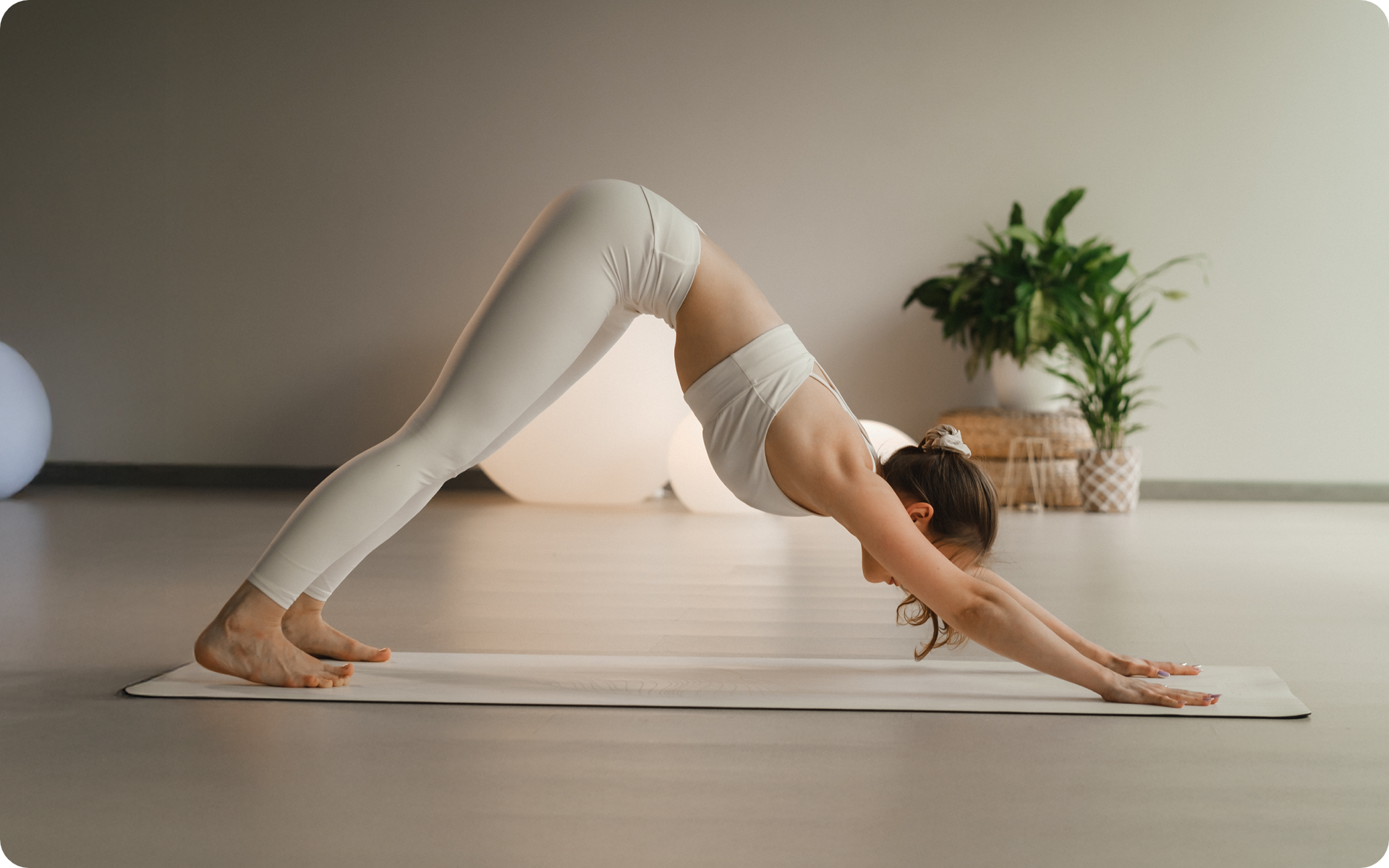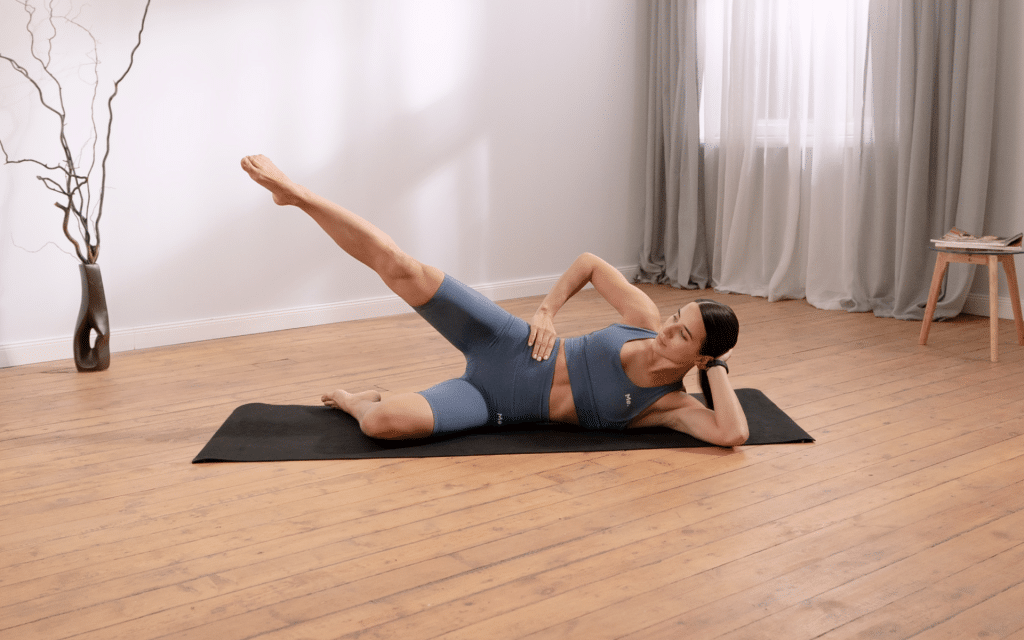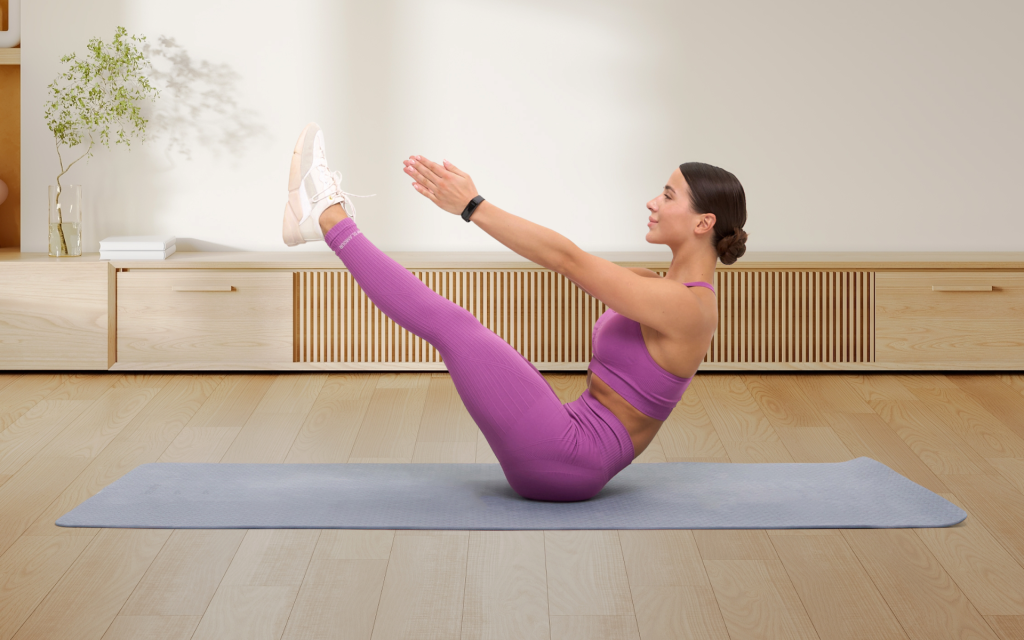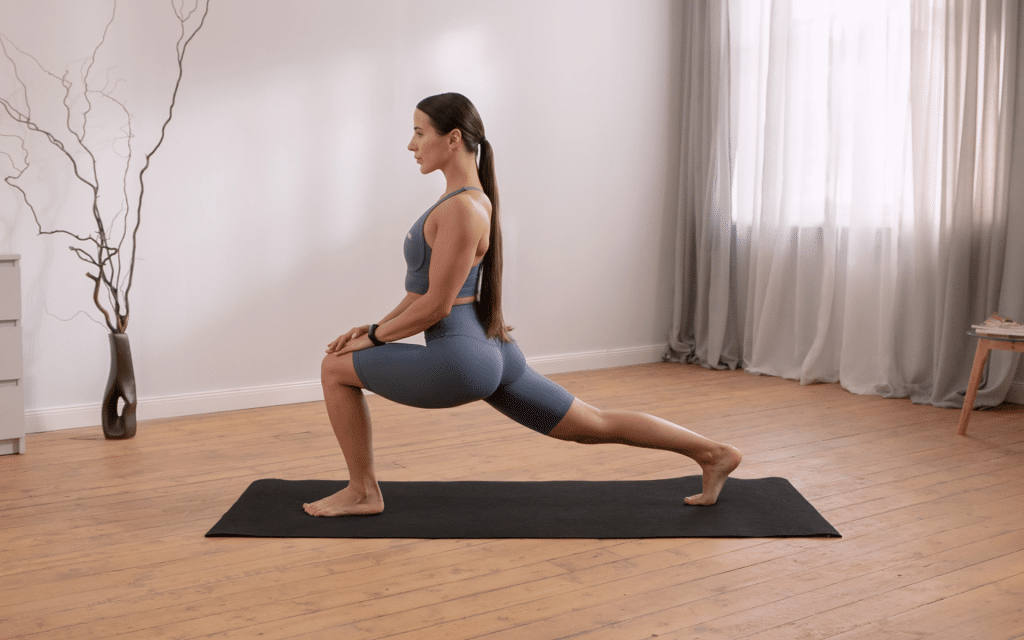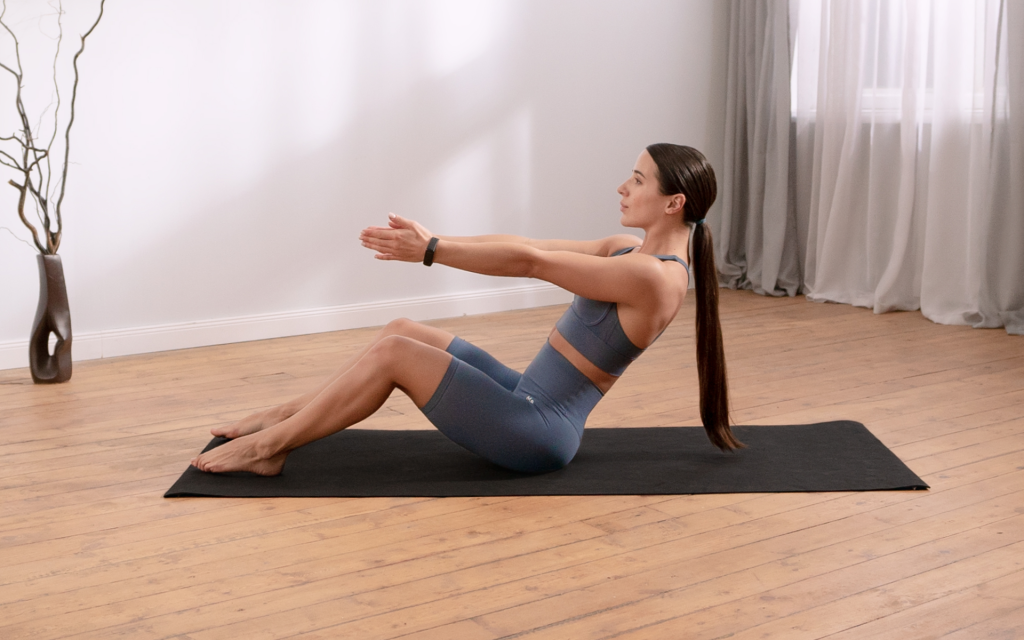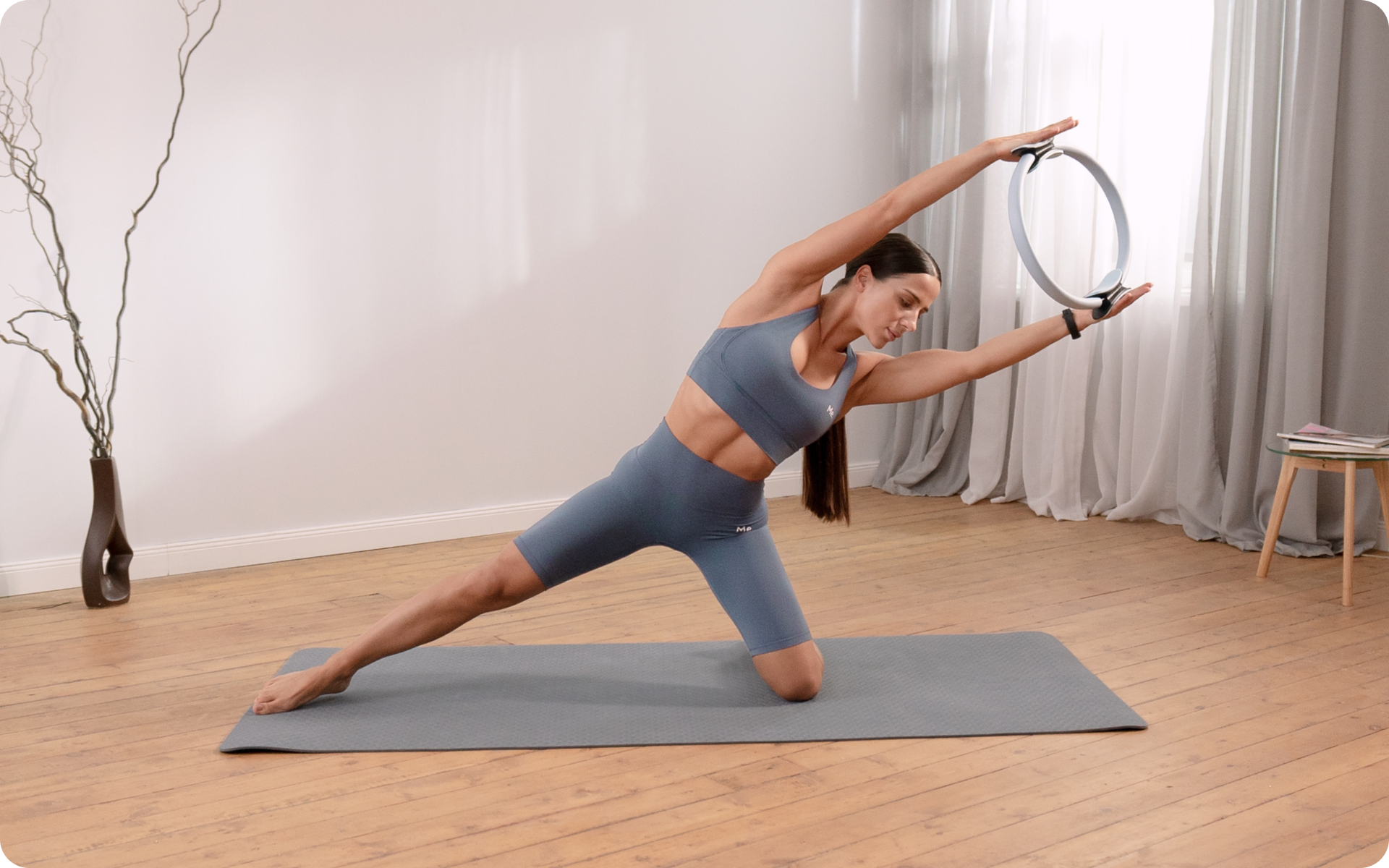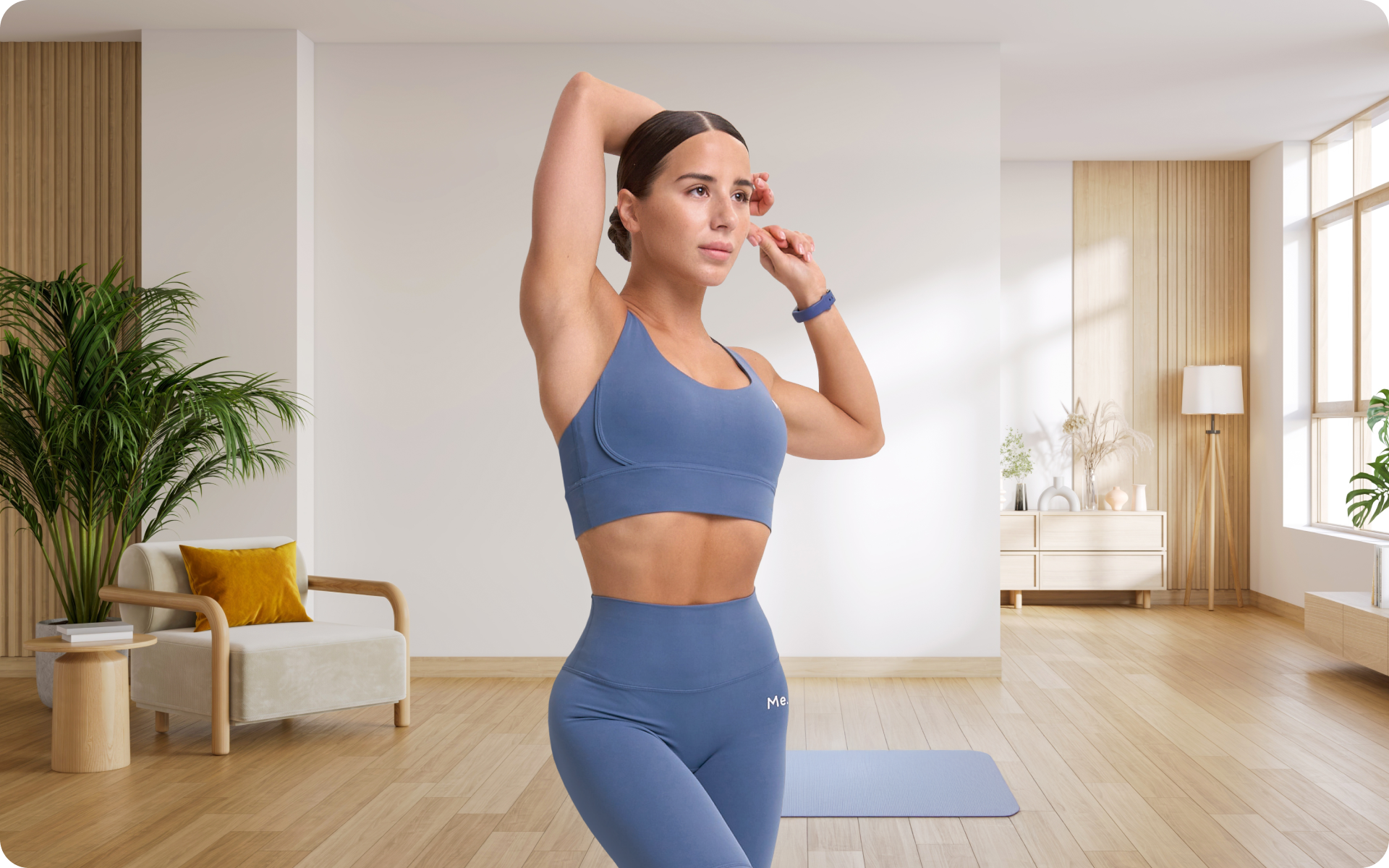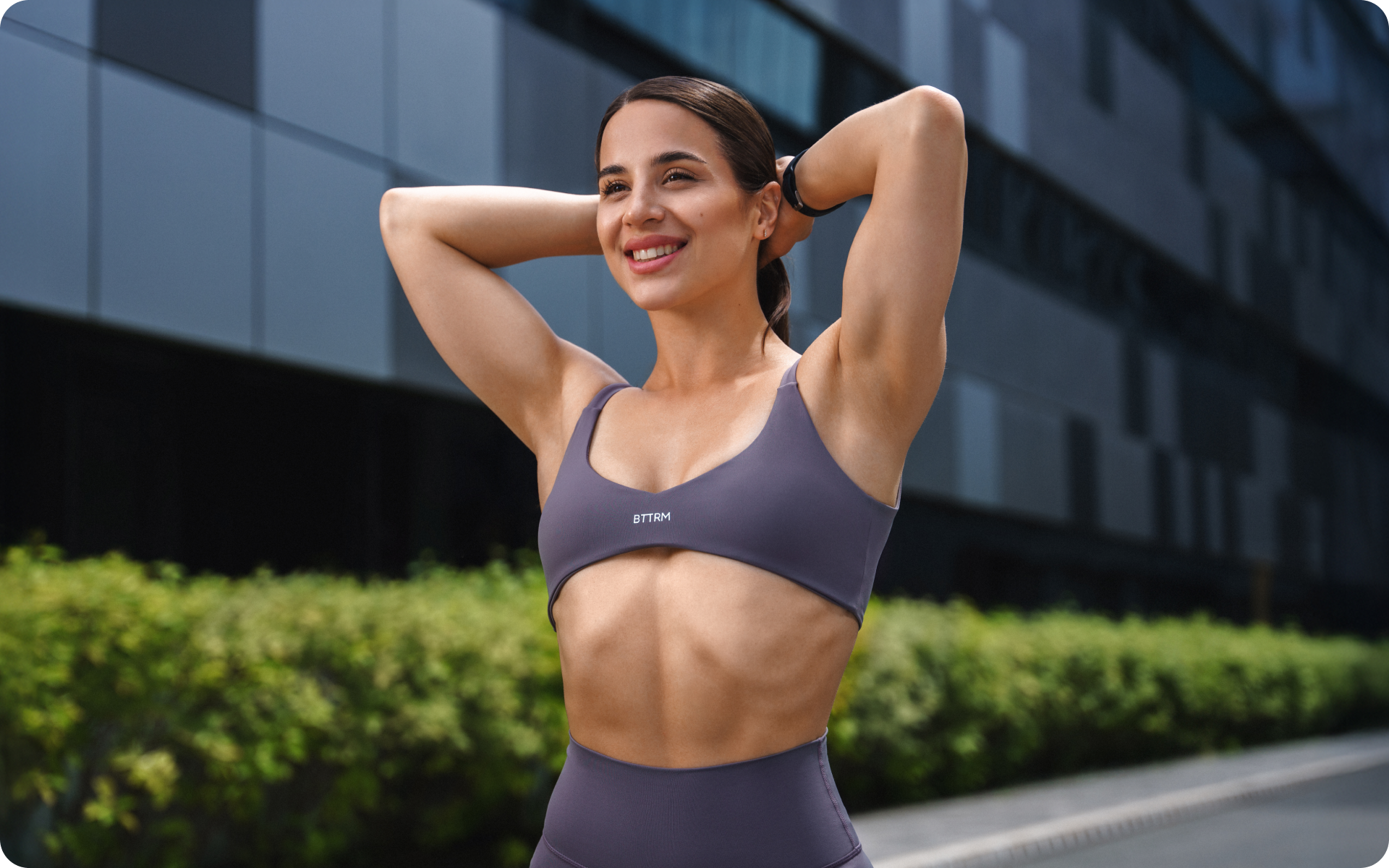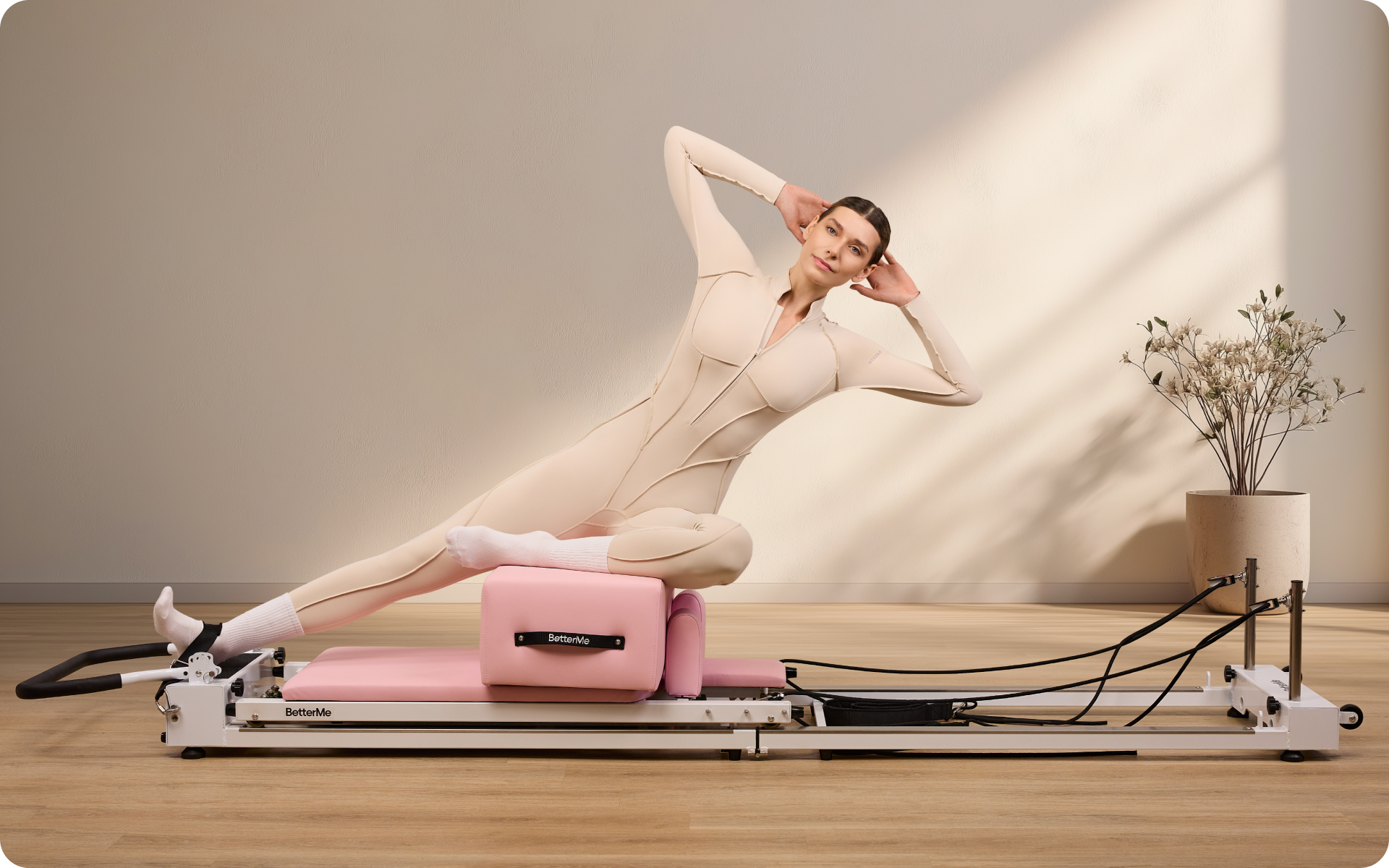Pilates has become the go-to activity for almost everyone who wants to improve their core strength and stability. You already know that it’s possible to do Pilates exercises at home or attend a studio where a professional instructor supervises you. In the studio, you also get a chance to master special Pilates machines that could add up to overall benefits.
But what if you don’t have enough time or money to attend Pilates sessions? Then surely doing Pilates at home is your plan B.
But is Pilates at home effective? Is it possible to get toned with it? Today we’re going to unveil the truth behind the efficacy of Pilates at home, some basic moves for beginners, and learn whether or not just 20 minutes of Pilates is enough.
Can You Do Pilates at Home and Get Results?
Can you do Pilates at home without equipment and get results? The answer may be different for everyone. A lot depends on the consistency of your workouts, your main goal, and progression.
However, you can get the basic perks with home Pilates workouts.
After consistent Pilates sessions, you may experience decreased back pain, and increased flexibility, strength, and mobility. In addition, you may improve your balance and regulate blood sugar levels (1).
According to another study, remote Pilates training could be an effective substitution for in-person sessions. It promotes physical fitness in healthy women, enhancing their lifestyle (2).
In this case, Pilates at home could be as helpful as in-studio training with an instructor.
However, there’s one drawback to consider here: beginners practicing Pilates at home are at a higher risk of performing exercises incorrectly, which can lead to decreased effectiveness or even injury.
Is At-Home Pilates as Effective as Machine Pilates?
Home Pilates can be highly effective, but it differs from reformer Pilates in terms of resistance, intensity, and muscle engagement. Mat-based home Pilates focuses on bodyweight exercises that strengthen the core, improve flexibility, and enhance overall body control. While it can effectively build strength and endurance, it may not provide the same level of resistance and support as a reformer. The reformer machine uses springs and pulleys to add adjustable resistance, which allows for a greater range of motion and targeted muscle engagement that can be more challenging than traditional mat exercises.
That being said, home Pilates can still deliver significant benefits, particularly when the exercises are performed with proper technique and progression. Many bodyweight movements that are used in mat Pilates are foundational to reformer workouts, and incorporating small equipment such as resistance bands, ankle weights, or stability balls can help mimic some of the resistance provided by a reformer. Ultimately, both forms of Pilates can be effective, and the best choice will depend on your individual goals, accessibility, and personal preference. Whether done at home or on a reformer, consistency and proper form are key to seeing progress.
Whether you’re a workout beast or just a beginner making your first foray into the world of fitness and dieting – BetterMe has a lot to offer to both newbies and experts! Install the app and experience the versatility first-hand!
Can You Get Toned Just Doing Pilates at Home?
Yes, you can improve muscle definition with home Pilates alone, but the extent of your results will depend on several factors, including workout intensity, consistency, diet, and overall body composition. Pilates is excellent for building muscular endurance, improving postural control, and enhancing core strength, all of which contribute to a more toned appearance. By performing bodyweight exercises that emphasize controlled movements and time under tension, home Pilates can help strengthen and sculpt muscles, particularly in the core, legs, and upper body. However, for significant muscle definition, additional factors must be considered.
If your goal is muscular hypertrophy (muscle growth) or fat loss to reveal muscle definition, incorporating other forms of exercise – such as resistance training and cardiovascular workouts – can enhance the results. Traditional strength training with added resistance, such as dumbbells or resistance bands, can create the progressive overload that is needed for muscle growth, while cardio can help reduce body fat for a more defined look. In addition, maintaining a well-balanced diet with adequate protein intake and allowing proper recovery are essential components of muscle development. While home Pilates can certainly contribute to muscle definition, combining it with strength training and proper nutrition will lead to the most noticeable and sustainable results.
Read more: Mat Pilates vs Reformer Pilates – Which One Should You Choose?
Is 20 Minutes of Pilates a Day Enough?
20 minutes of Pilates per day can provide significant fitness benefits when it’s performed consistently and with proper intensity. Pilates is known for improving core strength, flexibility, postural control, and muscular endurance, all of which contribute to overall fitness. A focused 20-minute session can effectively engage multiple muscle groups, enhance mobility, and promote better body awareness. For individuals who are looking to improve stability, balance, and functional strength, daily Pilates can be an excellent addition to a well-rounded fitness routine.
However, the extent of results will depend on individual goals and other lifestyle factors. If your goal is muscular hypertrophy or significant fat loss, Pilates alone may not be enough, and incorporating strength training or cardiovascular exercise could be beneficial. In addition, factors such as progressive overload, workout variety, proper nutrition, and recovery all play a role in achieving long-term fitness results. While 20 minutes of Pilates per day can lead to noticeable improvements in core strength and flexibility, combining it with other forms of training will yield the most comprehensive fitness benefits.
What Is the Most Effective Form of Pilates?
There is no universally “most effective” form of Pilates, as the best option depends on an individual’s goals, experience level, and personal preferences. Pilates comes in various forms, including mat Pilates, reformer Pilates, and contemporary variations that incorporate additional equipment or dynamic movements. Mat Pilates focuses on bodyweight exercises and can be highly effective for building core strength, improving flexibility, and enhancing overall body control, while reformer Pilates utilizes a specialized machine with springs and pulleys to provide adjustable resistance, which can add intensity and assist with movement precision. Both forms can deliver significant fitness benefits, but the best choice will depend on what aligns with an individual’s needs and lifestyle.
For those who are looking for convenience and accessibility, home-based mat Pilates may be the most effective as it requires minimal equipment and allows for consistent practice. If someone prefers guided instruction, structured resistance, or rehabilitation-focused exercises, reformer Pilates may be the better fit. In addition, individuals who are aiming for general fitness and mobility may benefit from a mix of both. Ultimately, the most effective form of Pilates is the one that is enjoyable, sustainable, and aligns with a person’s fitness goals, whether that means strengthening the core, improving flexibility, or enhancing overall body awareness.
What Is a Complete Home Pilates Workout?
If you’re a Pilates newbie or have honed some Pilates basics, you’re up for adding this full-body workout into your training routine. This workout requires no equipment apart from your body and a mat. Wear something comfy and jump into these PIlates exercises.
Some exercises are simple and others may feel more intense. Here are some Pilates moves that you could train today.
- Lower lift
- Side plank
- Glute bridge
- Half roll down
- Standing side kicks
- Criss-cross
- Pilates push-up
- Pilates one hundred
- Plank rock
Lower Lift
How to perform:
- Lie on the mat with your knees bent and your feet on the floor.
- Make a diamond with your hands and place them under your butt.
- Lift your legs straight up, placing your heels together, and let your knees turn outward, forming a diamond with your legs.
- Press into your hands, exhaling air out of your belly, and lower your legs to 45 degrees.
- Raise your legs back up to start.
- Do 8-10 reps.
Side Plank
How to perform:
- Get in a plant position keeping your abs tight.
- Move your right hand toward your left; pivot your feet, with your right foot behind the left, and rotate your body to the left.
- Have your hips raised and extend your right hand up; hold for 10 seconds.
- Return to the starting position and repeat on your right side.
- Do 8-10 reps per side.
Glute Bridge
How to perform:
- Lie on the mat and bend your knees with your arms at your sides and your palms facing down.
- Tuck your hips and roll up, starting with the small of the back and ending with your hips.
- Slowly lower back down, starting with the ribs.
- Do 8-10 reps.
BetterMe will shake off your mental funk, rid you of your energy-zapping habits, and help you sculpt the body of your dreams. Intrigued? Hurry up and change your life for the better!
Half Roll Down
How to perform:
- Sit on the mat with your knees bent, heels on the floor, and hands on the sides of your thighs.
- Exhale, pulling your abs in toward your spine and tilting your pelvis to press your lower back to the floor.
- Roll down, starting from your upper back, until your lower back touches the floor.
- Exhale and squeeze your glutes, then hollow the belly to roll back up to start.
- Complete 8-10 reps.
Standing Side Kicks
How to perform:
- Stand with your right foot on the ground and your left foot on the floor.
- Lift your left foot and keep your right knee soft.
- With your shoulders down and back, flex your foot, and extend your left leg forward.
- While squeezing your butt, pull your leg back.
- Do 8 to 10 reps.
- Circle your leg clockwise for 8 to 10 reps and counterclockwise for 8 to 10 reps.
- Repeat the entire series on the opposite leg.
Criss-Cross
How to perform:
- Lie face-up on the mat. Put your knees in the table-top position and your hands on your head with your elbows forward.
- Crunch up, bringing your elbows to your knees.
- Hold the position and shift your elbows out to the sides.
- Twist your right elbow toward the center of your body to touch your left knee.
- Return to the starting position and repeat on the other side.
- Do 8-10 reps per side.
Pilates Push-up
How to perform:
- Get in a high plank position with your elbows stacked over your hands and keep your abs tight. Beginners can do it on their knees.
- Squeeze your inner thighs.
- Bend your elbow, lowering down as far as possible without touching your chest to the ground.
- Push back up.
- Do 8-10 reps.
Read more: Pilates Exercises for Weight Loss: Transform Your Body with Every Move
Pilates One Hundred
How to perform:
- Lie face-up on the mat.
- Lift both legs toward the ceiling and lower them halfway.
- Curl your head up and reach your arms long alongside your body, palms down.
- Pump your arms up and down with an inhale for a five-count and exhale for a five-count.
- Repeat this breathing pattern 10-12 times while holding the position.
Plank Rock
How to perform:
- Get in a high plank position with your hands stacked under your shoulders.
- Rock your body forward toward your hands and then backward toward your heels.
- Ensure your core, butt, and quads are engaged the entire time.
This Pilates workout with 9 exercises can be done two to four times a week. If some exercises are too difficult for you or cause you pain, stop the activity and change it for another exercise.
Progress does not come with pain but the ability to complete challenging exercises when you’re physically prepared for them.
Neither yoga nor Pilates is universally more effective – it depends on an individual’s goals and preferences. Yoga emphasizes flexibility, balance, mindfulness, and stress reduction, with benefits for both the body and mind, while Pilates focuses on core strength, posture, alignment, and muscle endurance. If your goal is to improve flexibility and mental clarity, yoga may be more effective. If you’re looking to strengthen your core and improve functional movement, Pilates may be the better option. Both practices can complement each other, and choosing one depends on your specific needs and fitness objectives. Pilates can be self-taught to a certain extent, particularly for those who are starting with basic mat exercises. Many online resources, instructional videos and courses, and apps such as BetterMe can guide you through foundational Pilates movements. However, it’s important to maintain proper form to avoid injury and for this, a certified instructor can provide valuable feedback. For more advanced Pilates techniques or if you’re using equipment such as a reformer, it’s recommended to take classes or work with a trained instructor to ensure proper technique and avoid developing bad habits. Pilates is worth it for many people, as it offers numerous benefits, including improved core strength, better postural control, increased flexibility, and enhanced body awareness. It can be particularly beneficial for individuals who are looking to improve muscle endurance, rehabilitate after injury, or prevent muscle imbalances. In addition, Pilates can be easily adapted to suit various fitness levels and goals, which makes it a valuable addition to any exercise routine. If you’re looking for a low-impact workout that emphasizes controlled, purposeful movements, Pilates is certainly worth considering. Yes, it’s absolutely okay to do Pilates at home, and many people find it convenient and effective. Home Pilates allows you to practice at your own pace and on your own schedule. For beginners, mat-based Pilates exercises are a great way to start and there are plenty of online resources that can help guide you through routines. However, it’s essential to ensure you have the correct form and technique to avoid injury, particularly when attempting more advanced exercises. Starting with online classes, virtual instructors, or instructional videos can help provide structure and guidance in your home practice.Frequently Asked Questions
Is yoga or Pilates better?
Can Pilates be self-taught?
Is Pilates really worth it?
Is it OK to do Pilates at home?
The Bottom Line
Pilates workouts at home are an accessible way to improve your overall health without spending additional money and time on personal training.
This low-impact activity is a great option to improve your quality of life and make your body stronger.
Whether you train from home or with a trainer, you’re still moving, and that’s the most important thing for every person who wants to get healthier.
DISCLAIMER:
This article is intended for general informational purposes only and does not serve to address individual circumstances. It is not a substitute for professional advice or help and should not be relied on for making any kind of decision-making. Any action taken as a direct or indirect result of the information in this article is entirely at your own risk and is your sole responsibility.
BetterMe, its content staff, and its medical advisors accept no responsibility for inaccuracies, errors, misstatements, inconsistencies, or omissions and specifically disclaim any liability, loss or risk, personal, professional or otherwise, which may be incurred as a consequence, directly or indirectly, of the use and/or application of any content.
You should always seek the advice of your physician or other qualified health provider with any questions you may have regarding a medical condition or your specific situation. Never disregard professional medical advice or delay seeking it because of BetterMe content. If you suspect or think you may have a medical emergency, call your doctor.
SOURCES:
- Effects of Pilates on health and well-being of women: a systematic review (2023, springeropen.com)
- Remote Pilates Training Is Effective in Improving Physical Fitness in Healthy Women: A Randomized Controlled Study (2024, ncbi.nlm.nih.gov)
- The effects of Mat Pilates and Reformer Pilates in patients with Multiple Sclerosis: A randomized controlled study (2017, ncbi.nlm.nih.gov)
- Efficacy of Pilates in Functional Body Composition: A Systematic Review (2016, mdpi.com)
- The effects of Pilates and yoga participant’s on engagement in functional movement and individual health level (2019, ncbi.nlm.nih.gov )
- Low back pain (2023, who.int)
